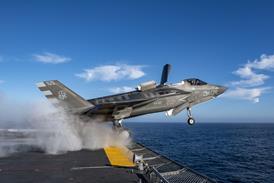ARIE EGOZI / TEL AVIV
Israel Military Industries (IMI) plans to conduct the first live test early next year of its modular stand-off vehicle (MSOV), which it is developing as a competitor to the Raytheon AGM-154 Joint Stand Off weapon.
The 1,050kg (2,300lb) MSOV is 3.97m (13ft) long with a wing span of 2.7m. IMI says it can carry a 675kg payload to a range of 100km (62 miles). It is creating a variety of advanced submunitions payloads, including dual purpose bomblets, combined effect bomblets and unitary and anti-runway penetrators.
MSOV uses GPS navigation that can be programmed on the ground or during flight. The weapon is designed for release from up to 35,000ft, after which it manoeuvres and glides to the target. During an unarmed MSOV launch in 2000 some problems were encountered during testing, but these have been solved, says the company.
IMI and Rafael have revealed plans to develop, produce and market a range of advanced air-to-surface weapons. "The agreement takes into account the co-operation we have with other companies, mainly Lockheed Martin," says Eitan Yudilevich, Rafael vice president business development and marketing. This includes the Rafael/ Lockheed Martin PGSUS joint venture that produces the AGM-142 Popeye missile in the USA. Israel and the US Navy have launched a $3 million eight-month study to further upgrade the Boeing AGM-84 Harpoon II anti-ship missile with a new seeker developed by Israel Aircraft Industries MBT division. The proposed venture aims to offer the proposed Harpoon Block 21 to USN and some of the other 23 countries operating the missile.Source: Flight International























